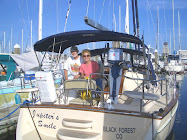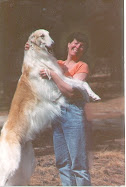 |
| Good bye Panama City |
We motored between the islands of Isla Taboguilla and Isla Taboga in the Gulf of Panama and headed to a lovely little cove on the northwestern side of Isla Bona and dropped the anchor.
We had motored because there was no wind. Now that it was later in the afternoon the wind came up, out of the north west and made our planned anchorage choppy and with a rocky, hard lee shore. One mile away to the north was the calm, south facing anchorage off Isla Otoque.
We went there with some concern because there was a local fishing boat anchored there and we were traveling alone.
 |
| A calm anchorage. Beyond the fishing boat is rough water. |
Night boardings had been reported and we planned to do all we could to discourage that from happening to us. The most recent boarding had been reported by a German boat anchored alone behind Punta Chame, on the mainland, about 45 miles away from our present location. We had the US flag flying and some think that that is actually a deterrent in itself, because in some people's minds, all Gringos carry weapons and are not afraid to use them; violent culture that we are. Well, we did what we could to protect valuables and locked our hatches, placed our motion sensing lights in the cockpit, zipped the enclosure and locked the companionway. After sundown the fishing boat got under way, but did not leave. They circled and circled, casting and retrieving their net while we slept (but it was a very light and watchful sleep.) We had eighty-four miles to travel the next day so at 0330 we got under way ourselves. The fishing boat was still working the area, just fishing - for fish - not us.
By noon we were crossing the western end of the Gulf of Panama, approaching Punta Mala. I was trying to time the tide so that the current was with us and the little wind that was blowing was with us as well. What can be the worst stretch of water on the Pacific coast of Panama was very good to us that day and we reached our planned anchorage at the popular surfing cove, Ensenada Benao with time to spare before sundown. Along the way, however, our depth sounder acted up, showing only 24.9ft of water where there was nearly 200ft. A factory reset recovered the depth for a moment and then it was lost again. I turned off the electronics until we approached Punta Benao and when I turned electronics on again the sounder behaved as it should, showing we had entered the cove and showing that we had chosen to anchor in about eleven feet of water at dead low tide. It was a pretty spot, but a rather rolly anchorage and we were happy to be on the move soon after sunup Monday.
Again, with little wind, we had about fifty-four miles to our next anchorage still traveling along the treacherous Azuero Peninsula and rounding it to Ensenada Narango. Even though there was little wind we were pleased that the conditions were mild. Since we were motoring, ran the water maker again. After about three hours, the depth sounder quit again. Factory resets did nothing to help so I turned electronics off again. This time however, when I turned them back on as we approached the anchorage, the sounder did not come back on. Barb said that she would reach off the swim platform with our handheld depth sounder to find our way to the anchorage. After almost reaching the anchoring location the depth sounder suddenly came back to life and agreed with Barb's depths. No explanations!
Ashore we could see a couple of orange trees with fruit, some goats and some dogs. No houses, no people. I began to dig into the sounder problem, following the hints given in the owner's manual. I think that will be a subject for a separate entry in the Blog that you may elect to avoid. This anchorage turned out to be somewhat rolly through the night so it was easy to wake up and be on our way. The DDS (damn depth sounder) worked as we woke up the boat, but I didn't want to press my luck. We turned off the instruments and proceeded using the iNavX application on the iPad . iNavX uses Navionics charts that are better than what we have on our chart plotter anyway. We rounded Isla Cebaco, turned North and approached the reef around Isla Santa Catalina. I held my breath as we turned on the instruments again. The DDS came on and we found our way into a very nice anchorage for the night.
The next morning the DDS became the DDDS (damned dead depth sounder) because it won't work at all. But this was 12/12/12 and that felt auspicious, so we headed out intending to reach Islas Ladrones before dark. As we approached Islas Ladrones in the waning light I thought that it would not be prudent to attempt this anchorage without the sounder and without better light, so we pressed on through the night and approached Golfito, Costa Rica at dawn. We followed the waypoints in the Sarana Guide, Explore Central America!-Part 2, to enter the harbor and as Barb reached to the surface of the water with the hand held sounder we knew we were anchoring in twenty-two feet of water at just after high tide right in front of Land Sea Marina. I switched the outboard motors on the dinghy from the 8hp Nissan to the 5hp Tohatsu, because I hadn't run that engine yet. It started right up, but as I moved the lever to put the motor into forward the lever came off in my hand. The twenty-year old plastic part had disintegrated. I switched engines again and we dinghyed ashore at Land Sea with our documents to begin the process of checking into Costa Rica. Katie was loads of help with directions and instructions. Dinghy privileges are $5/day and that includes use of the lounges and showers. We found an ATM that gave us 50,000colones (+/-$100) and we continued walking to the Immigration Office. The officer filled out a great deal of paperwork and gave us instructions and copies of the paperwork to deliver to the Quarantine Office (Agricultural Inspection), Aduana (Customs) and the Port Captain. We walked a good distance along the shoreline and found that the Quarantine Office was locked. We got a cab to take us to the Duty Free Zone and a guard directed us promptly to … the wrong office. The nice lady in the office walked us past the guard and to the correct office. We were doing our best to communicate, but it was very plain to everyone that our Spanish was almost, but not entirely adequate. Yet, everyone was willing to try to help the ignorant foreigners. Another foreign aspect of the day was that the offices were decorated for Christmas and it was sweltering hot outside. We grabbed a collectivo, which is a minivan having a capacity of "one more" that drives a set route like a bus, but stops where you wish to pick up and drop off passengers. They are how the locals get about and they are cheap. Barbie asked the driver if they were going by the Capitania de la Porta and the driver gave her a puzzled look. Barb realized she had just asked about the Captain of the Door. We all laughed and she corrected herself, Capitania de Puerto (or just Capitanaria would have also worked.) The process is all part of the adventure. Walking back toward the boat and stopping at the Quarantine Office yielded nothing, so we were almost checked into Costa Rica. We stopped for groceries at adequate super markets and a great fruit and vegetable market. Golfito is a convenient anchorage with leg power as the only required form of transport once ashore. It is very hot, however. The wildlife seems to enjoy it none the less and the howler monkeys tell everyone and everything so.
The next day, after a howling squall went through with us ashore, I saw that our quarantine flag was trailing in the water and that our flag halyard had parted below the Costa Rica courtesy flag (still flying). I took that as a sign that mother nature had cleared us into Costa Rica. The WiFi was pretty good at Land Sea for $1/day. I spent a great deal of time e-mailing a very patient Raymarine technician named Winston about our DDDS. He walked me through the testing of the depth sounder, its wiring, terminators and connectors. All that I tested seemed to be within acceptable ranges, so the problem must be within the depth sounder itself or the communications chip in the display unit or in the through hull triducer/transducer. I shall bring the unit and display with me in luggage back to the US for repair in the future. I will try to obtain an inexpensive, stand alone depth sounder to run along side the dead one as soon as possible. Our favorite eatery was the diner, Restaurante Buenos Dias, with good food and large servings at a cheap price. It is located opposite the gas station. The marine store had no depth sounder unfortunately. Our laundry was done, I had climbed the mast to repair the flag halyard, my Interneting was finished enough so it was time to move on. I visited the Port Captain and got our National Zarpe (clearance papers) to Playa del Coco.






No comments:
Post a Comment